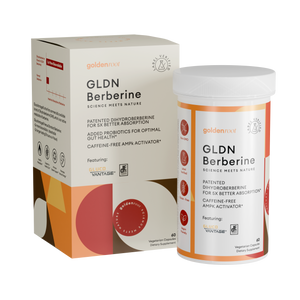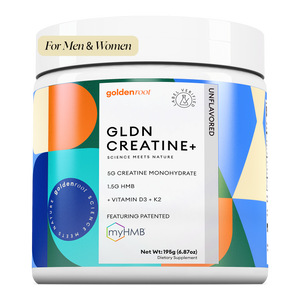Quick Answer:
Yes, creatine can be safely combined with GLP-1 medications like Ozempic or Wegovy. Creatine helps preserve lean muscle, support metabolism, and reduce fatigue, making it a valuable complement to GLP-1 therapy for weight management.
Creatine and GLP-1 medications may seem like they come from two different worlds; one from the gym, the other from the clinic!
But when it comes to supporting body composition and sustainable weight management, the two can actually complement each other in powerful ways. If you're using a GLP-1 medication like semaglutide (Ozempic, Wegovy) or liraglutide (Saxenda) to lose weight, layering in creatine might help preserve your muscle mass and keep your energy levels up. Here's how this duo works and why it matters!
What is GLP-1?
GLP-1, short for glucagon-like peptide-1, is a hormone your body naturally produces after eating. It helps regulate appetite + blood sugar levels by slowing digestion, reducing food intake, and enhancing insulin secretion.
GLP-1 receptor agonists {like semaglutide and liraglutide} mimic this hormone to help people with type 2 diabetes and those seeking weight loss.
GLP-1 drugs have gained major popularity for their ability to significantly reduce body weight. However, one downside is that a portion of that weight loss might come from lean muscle, not just fat, something that creatine may help counteract!
##creatine-calc
How Creatine Works
Creatine is a compound your body makes in small amounts and stores in muscles to support energy production. When you supplement with creatine monohydrate, you increase your muscles' ability to regenerate ATP (your cells' energy currency), which can enhance strength and endurance.
Over time, this leads to better workout performance, faster recovery, and greater muscle growth, particularly helpful when losing weight and at risk of muscle loss.
Read more: how long does it take for magnesium to work
How GLP-1 Works
GLP-1 medications reduce hunger by mimicking the effects of your natural GLP-1 hormone. They delay stomach emptying and help control blood sugar. This means you're likely to eat less without feeling as hungry, creating a natural calorie deficit that promotes fat loss.
But as calorie intake drops, so can your protein intake and overall nutrient levels, two factors that increase the risk of losing muscle.
That’s where creatine comes in: it helps bridge the gap by preserving muscle mass and performance.
Benefits of Combining Creatine and GLP-1
So, can creatine be taken with GLP-1 medications? Yes, and doing so may offer multiple advantages.
- Muscle Preservation: GLP-1 can reduce both fat and lean mass. Creatine helps ensure you retain muscle, which is essential for metabolic health.
- Improved Energy: Reduced calorie intake can lead to fatigue. Creatine helps support cellular energy, making workouts more productive.
- Better Body Composition: This combo helps you lose fat while maintaining or even gaining lean mass, ideal for sustainable weight loss.
For people using GLP-1 medications, creatine may be a simple, practical addition that supports overall fitness goals without disrupting medication efficacy.
Read more: What Effect Do GLP-1 Drugs Have on Bone Health and Muscle?
How Creatine Supports GLP-1 Weight Loss Goals
One of the biggest challenges with GLP-1-based weight loss is maintaining lean mass. Muscles play a vital and very important role in keeping your metabolism strong. Reduced muscle mass means a lower resting metabolic rate & making long-term weight maintenance harder.
Creatine supports muscle protein synthesis and performance & helps prevent the decline in muscle mass often seen with GLP-1 therapy. It also improves training output, which reinforces your ability to stay active while in a calorie deficit.
What to Expect When Combining Creatine with GLP-1
When you pair creatine with GLP-1, the effects can feel both subtle and significant:
- Stronger Performance in the Gym: You may find it easier to push through resistance training sessions, which are key for muscle retention.
- Better Recovery: Creatine supports faster recovery between sessions, allowing for more consistent progress.
- Balanced Weight Loss: The combination helps ensure more fat is lost while lean mass stays intact.
You won’t necessarily “see” creatine working the way you might with GLP-1’s appetite suppression, but over time, the results compound.
Read more: is creatine safe while breastfeeding
How to Take Creatine While on GLP-1
Most research supports a standard dose of 3-5 grams of creatine monohydrate per day. You don’t need to load or cycle it. It’s safe to take it year-round.
Timing: Creatine is flexible; it works whether you take it before or after a workout, or even with breakfast. For those on GLP-1 medications, many find it easiest to mix it into a post-workout protein shake or take it with a meal.
Consistency matters more than timing.
Hydration Guidance
How Much Water Should You Drink with Creatine on GLP-1?
Since creatine draws water into your muscles, hydration is essential. Aim for 2–3 liters of water daily while supplementing. If you’re on GLP-1 therapy, this also helps with potential side effects like constipation.
Potential Side Effects or Considerations
Creatine is one of the most well-researched and well-tolerated supplements on the market. For most healthy individuals, it causes no serious side effects. Some people may experience mild bloating initially, but this usually resolves within a few days.
There’s no evidence that creatine negatively interacts with GLP-1 medications. However, if you have kidney issues or take other medications, it’s smart to talk to your healthcare provider before starting any new supplement.
References & Sources





